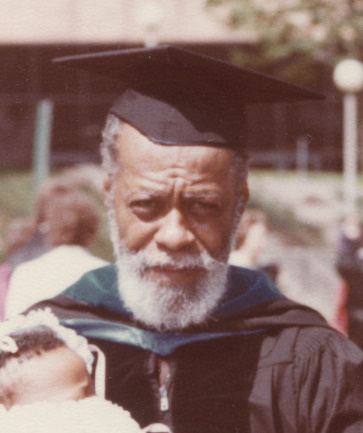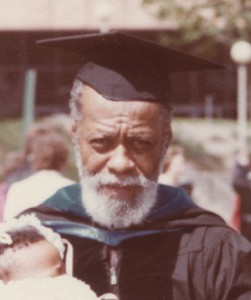
In honor of Nelson Mandela and the revolutionary spirit within each and everyone who reads POU, this week’s open threads will highlight Black/ African revolutionaries and nationalists. Using either education, research or political means these folks fought for changes that made their communities better or challenged the depths of white supremacy.
Edward Warren Crosby (born November 4, 1932), is an African-American professor/administrator emeritus, in the Department of Pan-African Studies at Kent State University (KSU). As a pioneer in the field of Black Education his most notable accomplishments include the creation of the Institute for African American Affairs, the predecessor of the Department of Pan-African Studies and The Center of Pan-African Culture at KSU. The Pan-African Studies Department (1969) and the Center of Pan-African Culture (1970) were two of the first institutions of their kind to be established at institutions of higher education.
Born and raised in the heart of Cleveland’s Hough neighborhood, site of the Hough Riots of 1966, he was the fourth child born to Frederick Douglass and Marion (Naylor) Crosby. He attended Our Lady of the Blessed Sacrament and St. Edward’s, Catholic parochial elementary and middle schools. As a young altar boy Edward aspired to be a priest, at that time. He was a straight “A” student, as well. However, he veered from the straight and narrow path he started out on when he transferred out of St. Edward’s in the eighth grade, unbeknownst to his parents. This change brought an abrupt end to his priestly aspirations, in 1948.
He earned his BA and MA from Kent State in 1957 and 1959 in German and Spanish and went on to earn a PhD from the University of Kansas in 1965. Oddly enough, his area of specialization was Medieval German Languages and Literature and Medieval History. In 1957 he began teaching at Kent State University and has since taught at a number of major and minor institutions around the country, including Hiram College, Tuskegee Institute, Southern Illinois University and the University of Washington.
Dr. Crosby founded and served as the director of the Institute for African American Affairs for seven years, from 1969 to 1976. In 1976, the Institute petitioned the university for departmental status which gave birth to the Department of Pan-African Studies (DPAS); thus Dr. Crosby served for 18 years as the Department’s first chair. The IAAA still exists, as a community development and research institute. The Department offers a multifaceted and holistic Africana Studies curriculum with a full-service educational world view, in Oscar W. Ritchie Hall, home of The Center of Pan-African Culture, which consists of The Henry Dumas Library, Mbari Mbayo Theatre and the Garrett Morgan Computer Lab, as well as a number of classrooms.
The Institute for African American Affairs (IAAA), now known as the Department of Pan-African Studies (1976), used a holistic curriculum model based on the earlier work of Dr. Crosby at Southern Illinois University, Edwardsville (SIUE). The curriculum he developed for the Experiment in Higher Education was similar to another program that was being developed at that time, known as Upward Bound, in that the students were from urban areas with low high school graduation rates. Both programs were designed to help these students enter institutions of higher learning and graduate successfully. Upward Bound students typically showed promise. However, EHE students’ test scores were not even on the border line. Dr. Crosby and his team developed a program that took that fact into account and developed another set of aptitude indicators to pick the 200 students that would be included in their program. Each of their teachers were also given training as counselors and therefore developed personal relationships with each and every one of their students. They also utilized a method of instruction that incorporated a methodology known as Each One Teach One, where the students instructed each other. Last, but not least, they validated the culture of the students they were working with by using examples, situations and language that the students were already familiar with to teach them subject matter they would encounter at any university.
His work in the realm of Black Education really began in East St. Louis, IL, even though he had previously spent a little more than a year at Tuskegee Institute, AL and a brief stint working with the Community Action Council in Akron, OH. As the director of education for the Experiment in Higher Education (EHE) Dr. Crosby and his team of fellow Kent State alumni developed a unique curriculum that taught them what they needed for college without denying the culture of their respective communities. The program developed in East St. Louis under the direction of Crosby, Hyman Frankel and Don Henderson has been cited as the first African Centered collegiate curriculum in the U.S. Black Studies programs, departments and institutes were developed at the behest of Black communities across the nation. East St. Louis, with its Black community of 70,000 was no exception. EHE’s influence on the development of Black Studies in universities across the nation was due in part to the amount of resources, time and brain power they had at hand to forge a pedagogy that put the student at the center of their learning. This Black Studies consortium did not confine their efforts to East St. Louis, they offered consulting services to universities from California to New York.
One of the lessons of East St. Louis was the importance of an interdisciplinary, holistic approach to Black Education. In East St. Louis EHE was partnered with Katherine Dunham’s Performing Arts Training Center (PATC). The symbiotic relationship between EHE and PATC attracted educators, as well as cultural icons from all over the U.S. and beyond to East St. Louis, buy viagra connect in us which generated a lot of energy in the community and attracted community members from all walks of life. On arriving at Kent, knowing the value of this kind of symbiosis, Dr. Crosby took on the task of developing an academic program modeled after the one he had previously spearheaded in East St. Louis and also took on the task of creating a cultural center that could work in tandem with the newly formed Institute for African American Affairs (IAAA). For 23 years this dual institution functioned with one purpose in mind, which was to provide an environment that reaffirmed the value of African American culture while helping their students learn to use the academic skills necessary to graduate from a four-year institution in the study and promulgation of this culture. The implementation of this kind of Black pedagogy has led to the successful graduation of hundreds, if not thousands, of students, that wouldn’t have made it otherwise, many of which have devoted their careers to working in Black communities all over the U.S. The Human Relations Center, which was founded in 1968, attempted to do this kind of work, however their perspective was that the students needed to assimilate. The Institute validated the students and their culture as worthy of emulation. The difference between the two could not be more clear cut.

